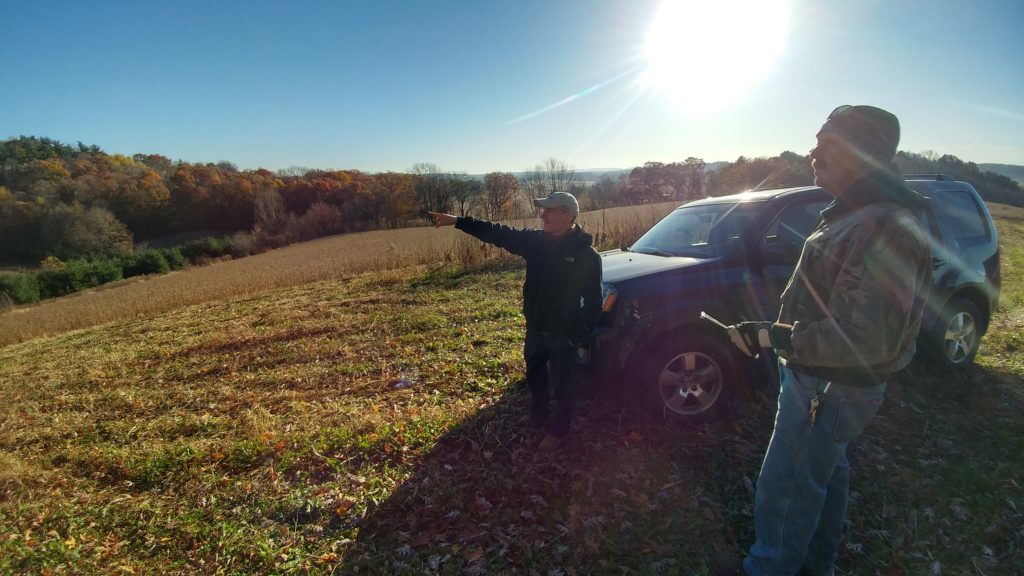
Lee’s First Walk in the Woods with a Forester
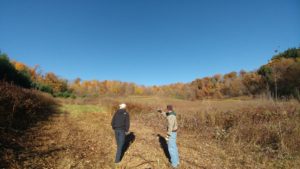
In his youth, Lee Bushmaker enjoyed spending time on his grandpa and grandma’s dairy farm in Adams-Friendship. Those formative moments seem to have left an impression on Lee, not only of good people, but of how good people connect to their land, of how they make it better, create purpose, and ultimately earn the respect of their community. “Being a landowner makes me want to be a better person–responsible, helpful, and useful,” Lee says.
In 2017, Lee Bushmaker bought fifty-seven acres of hill and valley in Dunn County, just off Highway 29 in western Wisconsin. Although a current resident of Minnesota, Lee grew up in central Wisconsin and never seriously considered buying anything other than a slice of his home state. There’s no question, the relationship between people and land is an emotional one.
To Lee’s credit, he knew what he didn’t know about his new purchase. A friend recommended he reach out to the professional natural resource community to learn what he could about his land. One of his first contacts was the county forester with the Department of Natural Resources. Lee quickly learned that a perk of his property taxes was the government staff’s willingness and ability to walk the land with him—a service that came to him free of charge, included in his taxes.
Rob Strand, the Dunn County forester, took Lee’s call and, in the course of their conversation, offered to walk the land and share his knowledge with Lee. They set a date for a couple of weeks out.
Lee and Rob met at the property on a sunny morning in October. After a little small talk at the tailgate, which focused on Lee’s purchase story and the property map, they struck out for the woods. The two soon hit it off.
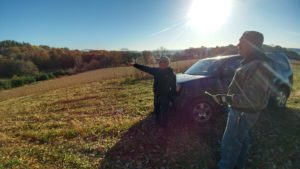
Lee’s broad smile and numerous questions put his eagerness and inexperience clearly on display. Let’s be brutally honest here–interactions that include a stark imbalance of knowledge can tempt manipulation. And yet, although Rob didn’t come close to matching Lee smile for smile, he never betrayed Lee’s trust, fielding every single question with his best answer, which in some cases was, “I don’t know.” The conversation swelled with an easy and open exchange, as eagerness and experience make a great pair–when there is trust.
Rob has been a service forester with the DNR for 26 years, spending the last 17 in Dunn County. At this point, he is very familiar with the history of natural resource management in the county and had even been to Lee’s property in the past. He knew the former owners, the past management history of the land, and the details of its sale. It’s like taking your car to a new mechanic and having them already know the car’s entire maintenance history. Rob’s basic value proposition to landowners enables him to casually make offerings such as, “I should be able to fill you in on the last eighty to ninety years.”
The High Points
It didn’t take Lee long to quickly discover an enjoyable and timeless element of ownership–sharing its special spots with others. The first stop wasn’t so much something on the land, but Lee’s excitement for the view. “That’s the view, pretty cool, eh? You can see the UW-Stout campus from here.” Lee relishes connections. Not only is the land in Wisconsin, and not only does it have a couple of agricultural fields; it was also visible from Menominee where he lived for three years after earning his accounting degree.
From atop the hill’s spine was a perfect spot for Rob to start “reading the land.” Rob compared the north- and south-facing slopes. “The south side has more oak and aspen, and the north side has sugar maple and basswood. Which is what you’d expect.” In addition to the types of trees, Rob also noted the age of most of the trees. Rob determined that both slopes were harvested about fifteen years ago. There is a very healthy crop of young trees, but another pattern existed too. The young trees are overtopped by larger, unhealthy trees. Rob explained that these were the trees that were left during that previous harvest because they were not economically valuable and the hillside would visibly remain “wooded” post-harvest.
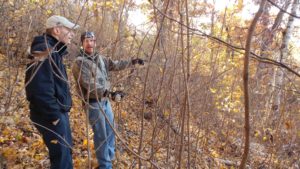
Rob’s recommendation was to, “Girdle the mature trees that are falling over to benefit the younger ones.” Girdling is a method of “choking” the tree by removing the bark and living tissue just below the bark around the stem of the tree to cut off the transport of water and energy between the leaves and roots. Rob explained that the dead standing tree will still provide valuable food and shelter for wildlife, but will no longer shade out younger trees or compete with them for resources.
“It’s a young forest, but there are a few things you can do. Think of it as a carrot patch and start to pick your favorites. Here’s a healthy red oak; ‘weed the carrots’ around it.”
Lee was encouraged to be assigned a project. “To see the young oaks makes me really happy.”
Brush and Trouble
On the walk, Lee was actively reconciling his relationship with brush. “How is buckthorn different than prickly-ash? Which one is worse?” To Lee, the trail system seemed like an obvious place to reassert control over brush, but what should his position be on brush off-trail? Rob assured Lee that the prickly-ash brush on the north side of the hill would eventually be out-competed by the sugar maple and basswood. However, the south side might require intervention because the brush will get more sunlight, and thus persist, and compete with young trees and wildflowers.
Rob also pointed out another brushy battlefield that hadn’t occurred to Lee: the field edges. It was one of several “aha” moments. Of course, once this was pointed out to Lee, it was clear to him that brush was steadily encroaching on the agricultural fields and providing safe harbor for potentially more trouble; in amongst the brush were scattered box elder trees, which are prolific seeders and pose a challenge to control their spreading. In the moment of realization, Lee’s idea to hire someone to brush out the trails expanded to include the field edges. Rob commended his choice to pick battles because, let’s face it, the war on brush is ongoing.
Eagerness and Experience
Depending on the project, Lee cast himself as either field general or solider–uncertain of what he had gotten himself into. “It goes from exciting to intimidating, back to exciting, and then back to intimidating.” Either role has its challenges–a “general” has to clearly explain to a contractor what he needs, while a “solider” needs to be able to execute the job correctly. Rob was very quick to relieve anxiety, saying, “Don’t get ahead of yourself, take it in pieces and look for progress little by little. You can begin in small ways to tend it.” Rob’s mustache curled up as he inserted a little dry humor, adding, “You can be what we call a ‘branch manager.’” The little bit of humor reminded Lee he is not on this journey alone. There is a support network of natural resource professionals a simple phone call away.
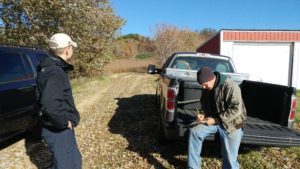
A lot of ground was covered in two hours, literally and figuratively. Rob committed to a follow-up letter that would summarize findings and recommendations. That was a welcomed relief for Lee because all of the information was a lot to take in.
Despite Lee’s uncertainty about his preparedness, the importance and meaning of land ownership never changed. “I want to be part of the community.” Lee enthusiastically embraced the challenge that his grandparents modeled; the best people put their shoulders into nurturing a piece of land for the betterment of themselves, their families, and their communities.
Reflecting on the forester’s visit
After Rob headed back to the forestry office, Lee reflected on the experience–his very first meeting with a forester with the Department of Natural Resources.
Here are some takeaways from Lee.
Overall – “He allowed me to see the potential of the land.”
Issues – “He made me less worried.”
Education – “He did it in a way that I understood.”
Attitude – “I learned patience is a good thing.”
Urgency – “Better to get to know the land before I change it.”
Opportunities – “There is lots to do, but also less.”
